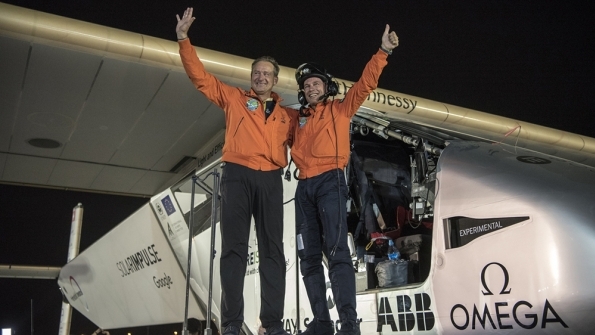-
Tips for becoming a good boxer - November 6, 2020
-
7 expert tips for making your hens night a memorable one - November 6, 2020
-
5 reasons to host your Christmas party on a cruise boat - November 6, 2020
-
What to do when you’re charged with a crime - November 6, 2020
-
Should you get one or multiple dogs? Here’s all you need to know - November 3, 2020
-
A Guide: How to Build Your Very Own Magic Mirror - February 14, 2019
-
Our Top Inspirational Baseball Stars - November 24, 2018
-
Five Tech Tools That Will Help You Turn Your Blog into a Business - November 24, 2018
-
How to Indulge on Vacation without Expanding Your Waist - November 9, 2018
-
5 Strategies for Businesses to Appeal to Today’s Increasingly Mobile-Crazed Customers - November 9, 2018
Solar Impulse Completes World Tour Without Fuel
Landing in Abu Dhabi yesterday – where it first took off in March 2015 – the plane finally completed its epic 25,000-mile record-breaking journey.
Advertisement
The plane made stops in Oman, India, Myanmar, China, Japan, the U.S., Spain, Italy, Egypt, and the United Arab Emirates.
Using an aircraft that was made of carbon fiber and which had a wingspan larger than that of a Boeing 747, the Solar Impulse team relied on an array of 17,000 photovoltaic cells located on the wings of the plane to collect energy from the sun, some of which powered the plane and some of which was stored in batteries so that it could fly during the nighttime. Its average airspeed was 46 miles per hour (75khm), though that increased during the day when the sun’s rays were strongest.
Although the Solar Impulse team planned to complete the global trip previous year, the mission had several setbacks, including some weather delays; however, the biggest holdup was when Solar Impulse 2 was grounded in July 2015 for about 10 months to fix severe battery damage suffered when crossing the Pacific Ocean.
The project has also been beset by bad weather and illness, which forced Piccard to delay the final leg. When he exited the airplane for the final time, Piccard (who manned the last leg of the trip) said to a crowd of onlookers in Abu Dhabi: “The future is clean”. The two pilots, Piccard and Borschberg, had to take turns flying solo for long days and nights. You can fly now longer without fuel than with fuel, and you fly with the force of nature, you fly with the sun.
United Nations Secretary-General Ban Ki-moon Monday hailed the determination and courage of the Solar Impulse flight team as the aircraft was about to complete its around-the-world journey.
“I worked for 15 years to have [this] demonstration of the improvements of these technologies, so now I really want to leverage this demonstration and create a world council for clean technologies”, Piccard said. The pilots had to sleep for 20 minute intervals and relieve themselves in their seat, unable to leave the tiny cockpit during flight.
Goggles worn over the pilot’s eyes flashed lights to wake him up while armbands worn underneath their suits buzzed when the plane was not at flying level. The pilot’s blood oxygen levels were monitored and sent back to ground control in Monaco. In 1999, he became the first person to circumnavigate the globe non-stop in a hot air balloon.
“We have now just watched our shared dream unveil, becoming a reality” the Solar Impulse team said in a blog post. Solar Impulse cost about $100 million to build and run.
Advertisement
The project is being supported by Solvay, Omega, Schindler and ABB. The flight was sponsored mainly by UAE-based Masdar, the Abu Dhabi government’s clean-energy company.





























